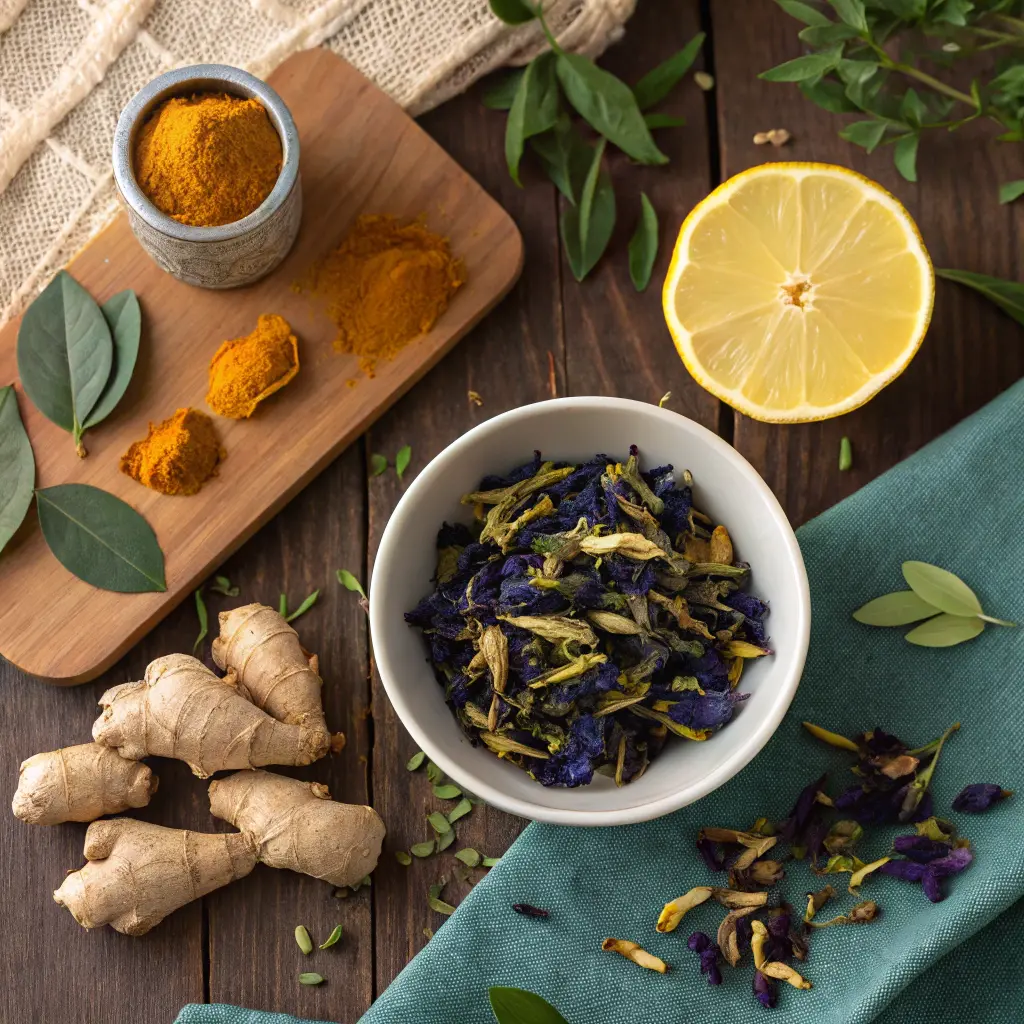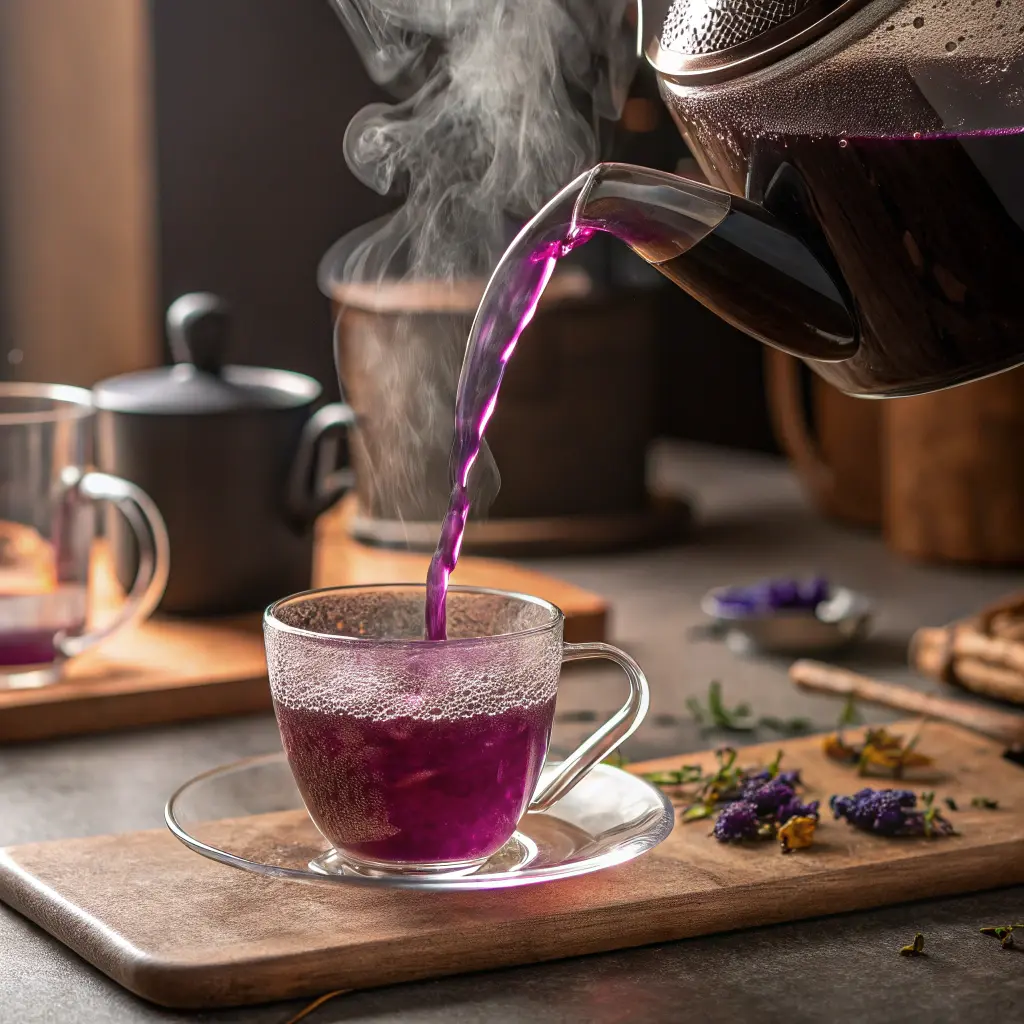Brazilian Mounjaro recipe is a naturally healing, root-based dish deeply connected to Brazil’s cultural and culinary traditions. Known for its earthy flavors and wholesome ingredients, this recipe brings together indigenous wisdom and Afro-Brazilian heritage in one nourishing bowl. In this article, we’ll explore everything from the powerful roots used in this dish to the exact steps to make it at home using all-natural ingredients.
Don’t miss our Brazilian herbal detox soup, perfect to complement your Mounjaro meal.
Whether you’re interested in holistic health or simply want a taste of authentic South American cuisine, the Brazilian Mounjaro recipe offers a grounding and deeply satisfying experience.
Table of Contents

Brazilian Mounjaro Detox Drink
Ingredients
Instructions
- Boil 2 cups of water in a saucepan.
- Once boiling, remove from heat and add the dried butterfly pea flowers. Let steep for 10 minutes.
- Strain the mixture to remove the flowers, retaining the infused liquid.
- Stir in the apple cider vinegar, lemon juice, and honey (if using) until well combined.
- For added flavor, mix in grated ginger (if using).
- Allow the drink to cool to room temperature or refrigerate for a chilled version.
- Serve over ice and garnish with fresh mint leaves, if desired.
Notes
- For a vegan version, substitute honey with maple syrup or agave nectar.
- Always use warm or room-temperature water to preserve the beneficial properties of the ingredients.
- Consult with a healthcare professional before starting any new dietary regimen, especially if you have underlying health conditions.
Nutrition
PART 1: What is the Brazilian Mounjaro Recipe?
Brazilian Mounjaro recipe: Origins and Cultural Relevance
Brazilian Mounjaro recipe has its roots in indigenous and Afro-Brazilian traditions, combining local plants, herbs, and tubers in a dish designed for healing and detoxification. This recipe is especially popular in rural Brazilian communities, where food is often used as medicine and prepared with spiritual intention.
The dish traces back to Brazil’s northeastern states like Bahia, where it is eaten during spiritual rituals and fasting periods. Core ingredients often include cassava (manioc), yam, turmeric, bitter herbs, and ginger, simmered slowly into a thick porridge or stew. Each household may adapt the recipe slightly, depending on the region or available ingredients.
This ancestral dish is considered an immune booster and digestive aid, making it a cornerstone in wellness-focused households throughout Brazil. Not just a meal, Mounjaro is symbolic of Brazil’s deep respect for nature and traditional medicine.
How the Brazilian Mounjaro Recipe Differs from Modern Adaptations
Unlike the pharmaceutical product Mounjaro used for diabetes or weight loss, the Brazilian Mounjaro recipe is a 100% food-based and holistic alternative. There are no injections, no chemicals—just roots, herbs, and traditional slow-cooked methods.
Let’s compare the Brazilian version with its modern namesake:
| Feature | Brazilian Mounjaro Recipe | Modern Mounjaro Product |
|---|---|---|
| Type | Food recipe | Injectable medication |
| Ingredients | Roots, herbs, natural spices | Synthetic drug (tirzepatide) |
| Purpose | Detox, immunity, gut health | Diabetes/weight loss management |
| Culture | Afro-Brazilian, Indigenous | Western medicine |
| Form | Porridge/stew | Injectable |
This comparison highlights the authenticity and healing nature of the original Brazilian recipe.
Learn more about Amazonian root vegetables used in Brazilian traditional meals.
By incorporating this natural approach into your kitchen, you’re not only choosing health—you’re honoring generations of Brazilian culinary wisdom.
PART 2: Key Ingredients in Brazilian Mounjaro Recipe
Brazilian Mounjaro recipe ingredients and their health benefits
Brazilian Mounjaro recipe relies on natural, whole ingredients that are not only nutrient-rich but also rooted in traditional healing practices. Each component is selected for its ability to nourish the body, improve digestion, and detoxify naturally.
Here’s a breakdown of the core ingredients and what they offer:
| Ingredient | Nutritional Value | Health Benefit |
|---|---|---|
| Cassava (Manioc) | High in complex carbs, Vitamin C | Provides energy, boosts immunity |
| Yam or Sweet Potato | Rich in fiber, potassium, Vitamin B6 | Supports digestion, balances blood sugar |
| Ginger Root | Anti-inflammatory, antioxidant | Aids digestion, reduces inflammation |
| Turmeric | Curcumin content, anti-inflammatory | Detoxifies liver, reduces joint pain |
| Bitter Herbs (Jaborandi, Boldo) | Alkaloids and bitter compounds | Stimulate bile, promote liver function |
| Garlic and Onions | Sulfur compounds, antimicrobial | Improve heart health, strengthen immunity |
| Olive Oil or Coconut Oil | Healthy fats, Vitamin E | Boosts absorption of nutrients, heart-healthy |
| Chili or Cayenne (optional) | Capsaicin, antioxidants | Speeds up metabolism, clears sinuses |
Most of these ingredients are easily found in Brazilian markets, health food stores, or online herbal apothecaries. For the most authentic taste and effect, choose organic or locally grown versions whenever possible.
Discover great ideas like our Brazilian cassava stew, which shares similar root-based health benefits.
Where to Source Authentic Brazilian Ingredients
Getting your hands on the right ingredients is crucial to making an effective and authentic Brazilian Mounjaro recipe. While some components like cassava or ginger are common, others like jaborandi or boldo might require specialty sourcing.
Here are a few tips:
- Local Brazilian markets or Latin grocery stores: They often stock fresh manioc, boldo tea leaves, and specialty herbs.
- Ethnic food sections in health stores: Look for organic turmeric root, dried bitter herbs, or frozen cassava.
- Online herbal shops: Search for trusted South American suppliers that sell detox-friendly herbs.
- Grow your own: Herbs like boldo, ginger, and turmeric can thrive in containers in sunny kitchens or gardens.
Check out this guide on sourcing traditional Latin American ingredients, including bitter roots and detox herbs.
Proper sourcing ensures the authenticity and effectiveness of your dish—especially if you’re making the recipe for detox or wellness.
PART 3: How to Make the Natural Brazilian Mounjaro Recipe
Step-by-step instructions to prepare Brazilian Mounjaro recipe
Brazilian Mounjaro recipe is traditionally slow-cooked, allowing the natural flavors and healing properties of each root and herb to fully infuse. It’s simple, earthy, and incredibly satisfying—perfect for those looking to eat clean without sacrificing flavor.

Ingredients:
- 2 cups peeled and cubed cassava (manioc)
- 1 cup peeled and cubed yam or sweet potato
- 2 tbsp grated fresh ginger root
- 1 tbsp turmeric root (fresh or powdered)
- 3 cloves garlic, minced
- 1 small onion, chopped
- 1 tbsp olive oil or coconut oil
- 2 tsp chopped bitter herbs (such as boldo or jaborandi)
- 4 cups filtered water or homemade vegetable broth
- Optional: ½ tsp cayenne or chili flakes for heat
- Salt to taste
- Fresh parsley or cilantro for garnish
Instructions:
- Prep the roots
Wash, peel, and cube cassava and yam. Soak cassava in cold water for 30 minutes to reduce bitterness and release natural cyanides. - Sauté the aromatics
In a large pot, heat oil over medium heat. Add onions and garlic, sauté until fragrant and lightly golden. - Add roots and herbs
Toss in ginger, turmeric, cubed yam, and drained cassava. Stir well to coat in the aromatic base. - Add liquid
Pour in filtered water or broth. Bring to a boil, then reduce to a low simmer. - Add bitter herbs and seasoning
Mix in boldo or jaborandi, salt, and cayenne if using. Stir and let simmer uncovered for 35–45 minutes. - Mash slightly (optional)
For a porridge-like texture, mash some of the roots using the back of a spoon or blend briefly with an immersion blender. - Garnish and serve
Top with chopped parsley or cilantro. Serve warm, as a standalone healing meal or with a light side salad.
Looking for inspiration? Try this sweet potato and turmeric Brazilian stew for a fusion twist on the classic.
Tips for First-Time Cooks to Get It Right
If you’re new to preparing traditional Brazilian root dishes, don’t worry—this Brazilian Mounjaro recipe is beginner-friendly. Here are some expert tips to ensure success:
- Don’t skip soaking the cassava. It’s a crucial step to make it safe and palatable.
- Go slow and low. The longer it simmers, the richer and more medicinal the flavor becomes.
- Use a clay or heavy-bottomed pot to maintain even heat and bring out the best taste from the roots.
- Balance the bitterness of herbs with a hint of lime or lemon juice at the end.
- Store leftovers properly. This recipe keeps well in the fridge for up to 3 days and tastes even better reheated.
Check out our article on cooking with boldo leaves to learn how to balance bitter herbs in Brazilian cuisine.
By following this natural preparation, you’ll experience the true essence of Brazilian Mounjaro recipe—deeply grounding, rich in culture, and crafted with care.
PART 4: Nutritional Value of Brazilian Mounjaro Recipe
Brazilian Mounjaro recipe nutritional profile: Calories, Carbs, and Protein
Brazilian Mounjaro recipe isn’t just comforting—it’s naturally nutritious. Made with whole foods like cassava, yams, and healing herbs, it’s a smart option for those seeking a clean, plant-based meal that still offers balanced energy.

Here’s a general nutritional breakdown per 1-cup serving:
| Nutrient | Estimated Amount |
|---|---|
| Calories | 180–220 kcal |
| Carbohydrates | 30–35g |
| Protein | 2–4g |
| Fat | 6–8g (from healthy oils) |
| Fiber | 4–6g |
| Sodium | Varies (based on added salt and broth) |
The primary energy source comes from complex carbohydrates in cassava and yam. These slow-digesting carbs help maintain blood sugar stability, making this dish ideal for energy without spikes or crashes.
The small amount of protein comes mostly from root vegetables and any added seeds or nuts, though it can be enhanced with plant-based protein toppings like hemp seeds or lentils if desired.
The fat content depends on the oil used—olive oil and coconut oil offer healthy monounsaturated and saturated fats respectively, which help in nutrient absorption and support brain and heart health.
Vitamins, Fiber, and Natural Fat Content
When you prepare a Brazilian Mounjaro recipe with fresh roots and herbs, you’re also tapping into an impressive vitamin and mineral profile:
- Vitamin A (from yams and turmeric): Supports eye health and immune function
- Vitamin C (from cassava): Boosts immunity and collagen production
- Vitamin E (from oils): Acts as a powerful antioxidant
- Potassium (from yams): Regulates blood pressure and fluid balance
- Magnesium (from roots and herbs): Aids muscle recovery and sleep
Additionally, the fiber content supports gut health and promotes satiety. Each serving helps reduce bloating and improve digestion, especially when consumed as part of a detox or plant-based meal plan.
The inclusion of anti-inflammatory herbs like ginger and turmeric not only boosts flavor but also adds natural compounds like curcumin and gingerol, which are studied for their disease-fighting properties.
Don’t miss our natural anti-inflammatory foods guide, packed with ingredients also found in Mounjaro.
Whether you’re tracking macros or just trying to eat clean, this recipe delivers nutrition and healing in every bite. It’s suitable for vegetarian, gluten-free, and even low-fat diets depending on how it’s modified.
PART 5: Variations of Brazilian Mounjaro Recipes
Vegan and Vegetarian Brazilian Mounjaro recipe adaptations
Brazilian Mounjaro recipe naturally leans vegetarian, but making it fully vegan is easy and keeps all its detoxifying benefits intact. By skipping animal-based broths and avoiding optional add-ins like eggs or cheese, this dish becomes a fully plant-powered superfood bowl.
Here are some ways to veganize and diversify it:
- Swap broth: Use homemade vegetable stock or kombu broth instead of bone broth.
- Add legumes: For a protein boost, stir in cooked black beans, lentils, or chickpeas toward the end.
- Enhance greens: Include nutrient-rich greens like collard greens, kale, or caruru (Brazilian spinach) for iron and vitamin C.
- Top with seeds: Garnish with flaxseeds, pumpkin seeds, or hemp hearts for omega-3s and texture.
These adjustments not only make the Brazilian Mounjaro recipe suitable for vegans but also improve its fiber and protein profile. The flavors remain bold, earthy, and deeply satisfying.
Check out our vegan Brazilian comfort meals collection for more ideas like this.
Low-Carb and Keto-Friendly Brazilian Mounjaro recipe options
Traditional Brazilian Mounjaro recipe uses starchy roots like cassava and yam, which are rich in carbs. For low-carb or keto followers, you can modify the recipe without losing its cultural essence.
Here’s how:
- Swap cassava/yam with turnips, cauliflower, or rutabaga: These lower-carb roots mimic the texture but slash the carb content.
- Reduce cooking time: Low-starch veggies cook faster and don’t require long boiling.
- Use MCT oil or avocado oil instead of olive or coconut oil for keto fat optimization.
- Include mushrooms or eggplant: These meaty veggies absorb flavor beautifully and keep it hearty.
| Ingredient Swap | Carb-Heavy | Low-Carb Alternative |
|---|---|---|
| Cassava | 38g carbs per cup | Rutabaga: 12g carbs |
| Yam | 27g carbs per cup | Turnip: 8g carbs |
| Sweet potato | 26g carbs per cup | Cauliflower: 5g carbs |
These tweaks offer all the immune-boosting benefits of the original Brazilian Mounjaro recipe, but fit within modern diet plans like keto, paleo, or low-GI. The result? A lighter dish that still tastes authentic and grounding.
Learn more about keto-friendly root vegetable substitutes to experiment with this recipe.
PART 6: Brazilian Mounjaro vs. Other Herbal or Root-Based Recipes
Brazilian Mounjaro recipe compared to African and Caribbean counterparts
Brazilian Mounjaro recipe shares similarities with various traditional dishes across Africa and the Caribbean, which also utilize medicinal roots, tubers, and herbs. However, the preparation methods, flavor profiles, and spiritual importance vary by region.
Here’s how it stacks up:
| Dish | Region | Key Ingredients | Differences |
|---|---|---|---|
| Fufu | West Africa | Cassava, plantain, yam | Typically pounded, served as a starch base |
| Pepperpot | Caribbean | Cassava, meat, spices | Includes meat and cassareep (spiced sauce) |
| Mounjaro | Brazil | Cassava, yam, bitter herbs | Fully plant-based, medicinal focus |
| Moqueca de Raiz | Brazil | Roots, coconut milk, dendê oil | Similar ingredients but more stew-like |
What sets the Brazilian Mounjaro recipe apart is its healing purpose and simplicity. It’s not just a side or flavor enhancer—it’s the main event, rich in therapeutic herbs. The boldo and jaborandi, for instance, are almost exclusive to Brazilian herbal medicine and rarely seen in African or Caribbean dishes.
Additionally, Mounjaro is usually served as a solo dish or part of a detox regimen, unlike other root-based meals that accompany proteins or sauces. Its consistency is thicker than African fufu but smoother than Caribbean pepperpots.
Discover great ideas like our Caribbean root and herb soup for a unique cultural spin.
Unique herbs and roots in Brazilian cooking traditions
Brazilian cuisine is a fusion of indigenous, African, and Portuguese traditions—and this comes through in the unique herbs and roots used in the Brazilian Mounjaro recipe. While garlic and turmeric are common globally, Brazil also features ingredients rarely used outside of South America.
Here are a few examples:
- Jaborandi: Known for its cleansing alkaloids, it stimulates salivation and supports liver function.
- Boldo: A traditional digestive aid used in teas and stews for liver detox.
- Guaco (Mikania glomerata): A climbing vine used for respiratory health and immune support.
- Açafrão-da-terra: Brazilian turmeric, milder and more fragrant than Indian varieties.
These herbs reflect a tradition of using food as medicine, a principle passed down by both indigenous tribes and Afro-Brazilian healers. Cooking with these ingredients isn’t just about flavor—it’s about treating food as holistic care.
Looking for more? Check out our guide to Brazilian healing herbs and how to cook with them.
Incorporating these unique roots and herbs adds depth and authenticity to the Brazilian Mounjaro recipe, and brings centuries of healing tradition right into your kitchen.
PART 7: Best Ways to Serve Brazilian Mounjaro Recipe
Pairing suggestions and ideal serving temperatures
Brazilian Mounjaro recipe is traditionally served warm, often as a thick, porridge-style stew that’s both grounding and filling. While it’s nutritious enough to stand alone, pairing it with complementary sides enhances the experience and balances its earthy profile.
Here are some serving ideas:
- Warm: Always serve Mounjaro warm, fresh off the stove or gently reheated. The warmth enhances the medicinal properties of roots and herbs.
- With steamed greens: Serve alongside caruru, collard greens, or sautéed kale to add more fiber and micronutrients.
- Grilled plantains: Their sweetness balances the mild bitterness of the herbs.
- Brown rice or quinoa: For those wanting a bit more bulk, these grains pair well and remain in the plant-based family.
- Fermented sides: A spoon of Brazilian pickled vegetables (conserva) or sauerkraut aids digestion and supports gut health.
- Fresh lime wedges: A dash of citrus brightens up the dish and balances strong root flavors.
Looking for inspiration? Try this plantain and greens combo that pairs beautifully with Mounjaro.
Traditional sauces and Brazilian sides that complement the dish
The Brazilian Mounjaro recipe may be simple, but it’s often accompanied by deeply flavorful, traditional sauces or small sides that enhance its natural taste without overwhelming its healing purpose.

Here are classic additions:
| Side/Sauce | Description | Why It Works |
|---|---|---|
| Molho de Pimenta | Spicy chili and vinegar sauce | Adds heat and acidity |
| Molho de Alho | Garlic-based dipping sauce | Enhances the root’s earthiness |
| Vinagrete | Tomato, onion, and vinegar salsa | Brings freshness and crunch |
| Farofa de Banana Verde | Toasted green banana flour | Adds texture and healthy resistant starch |
| Aipim Frito (Fried Cassava) | Crispy on the outside, soft inside | A crispy contrast to the creamy stew |
Culturally, Mounjaro is served during fasts or healing ceremonies with light sides, never heavy meats or dairy. This ensures the dish remains digestible and doesn’t interfere with the body’s detox process.
Don’t miss our authentic Brazilian side dishes guide to pair with your next wellness meal.
By serving it correctly, you elevate the healing benefits and honor the cultural roots of the Brazilian Mounjaro recipe. Whether you’re enjoying it during a detox or just craving soulful comfort food, this dish fits beautifully into a wholesome, balanced meal.
PART 8: Frequently Asked Questions About Brazilian Mounjaro Recipe
What are the ingredients in Brazilian Mounjaro?
The Brazilian Mounjaro recipe is built around natural, whole-food ingredients known for their cleansing and healing properties. While family variations exist across Brazil, the most commonly used ingredients include:
- Cassava (manioc) – A starchy root that forms the hearty base
- Yam or sweet potato – Adds fiber, flavor, and natural sweetness
- Fresh ginger root – Aids digestion and adds spice
- Turmeric – Known for anti-inflammatory and detoxifying benefits
- Garlic and onions – Classic flavor-builders with immune-boosting qualities
- Boldo or jaborandi – Traditional bitter herbs used for liver and digestive health
- Olive oil or coconut oil – Healthy fats that enhance nutrient absorption
- Filtered water or vegetable broth – The liquid base for simmering
- Optional spices – Chili flakes, cayenne, or bay leaf for added flavor
- Fresh herbs (parsley or cilantro) – For garnish and added nutrients
These ingredients are easy to source from ethnic markets or online stores. Together, they create a dish that’s both comforting and medicinal—perfect for gut health, detox, and overall well-being.
Discover great ideas like our cassava and ginger healing broth, which shares roots with the Mounjaro tradition.
What is the natural Mounjaro recipe?
The natural Mounjaro recipe is a traditional Brazilian preparation that uses plant-based roots, healing herbs, and spices to create a warm, grounding meal. Unlike the pharmaceutical product of the same name, this version is food—not medicine—and comes from centuries of Afro-Brazilian and indigenous culinary practice.
Here’s a simplified version of the natural recipe:
Ingredients:
- 2 cups cassava (peeled and cubed)
- 1 cup yam or sweet potato
- 2 tbsp grated ginger
- 1 tbsp turmeric (fresh or powdered)
- 3 cloves garlic
- 1 small onion
- 1 tbsp boldo or jaborandi (bitter herb)
- 1 tbsp olive or coconut oil
- 4 cups water or broth
- Salt to taste
Instructions:
Sauté the garlic and onion, add the roots and herbs, cover with water, and simmer for 35–45 minutes. Mash slightly for a porridge texture and serve warm, garnished with parsley or lime.
This dish is naturally gluten-free, vegan, and full of anti-inflammatory properties. It’s often consumed during spiritual fasts, detox periods, or simply as a deeply nourishing meal.
Looking for more healing soups? Try our Brazilian root detox bowl packed with similar ingredients.
PART 9: Conclusion and Final Thoughts
Why you should try Brazilian Mounjaro recipe today
Brazilian Mounjaro recipe is more than just a meal—it’s a legacy of natural healing, cultural resilience, and culinary simplicity. In a world filled with processed foods and synthetic solutions, this dish brings us back to our roots—literally. Its detoxifying ingredients, ancestral herbs, and earthy flavors make it a powerful addition to any wellness-focused kitchen.
Whether you’re exploring plant-based eating, interested in natural detoxes, or simply want a comforting, traditional Brazilian meal, Mounjaro checks every box. It’s warm, clean, and full of intention.
From cassava and yam to boldo and turmeric, every component plays a role in supporting digestion, boosting immunity, and grounding the body. Plus, with so many variations—from vegan to keto—you can customize it for any lifestyle.
Check out our complete guide to natural Brazilian recipes for more inspiration to keep your meals as healing as they are delicious.
Where to find more authentic Brazilian recipes
If the Brazilian Mounjaro recipe has sparked your interest in holistic cuisine, there’s a whole world of Brazilian plant-based meals waiting to be explored. From root-based soups to herb-infused stews, these dishes offer the perfect balance of flavor and functionality.
Don’t miss our Afro-Brazilian wellness foods list and tropical root cooking basics, both perfect next steps after mastering Mounjaro.
So, grab your roots, prep your herbs, and get cooking. Your body—and your tastebuds—will thank you.

